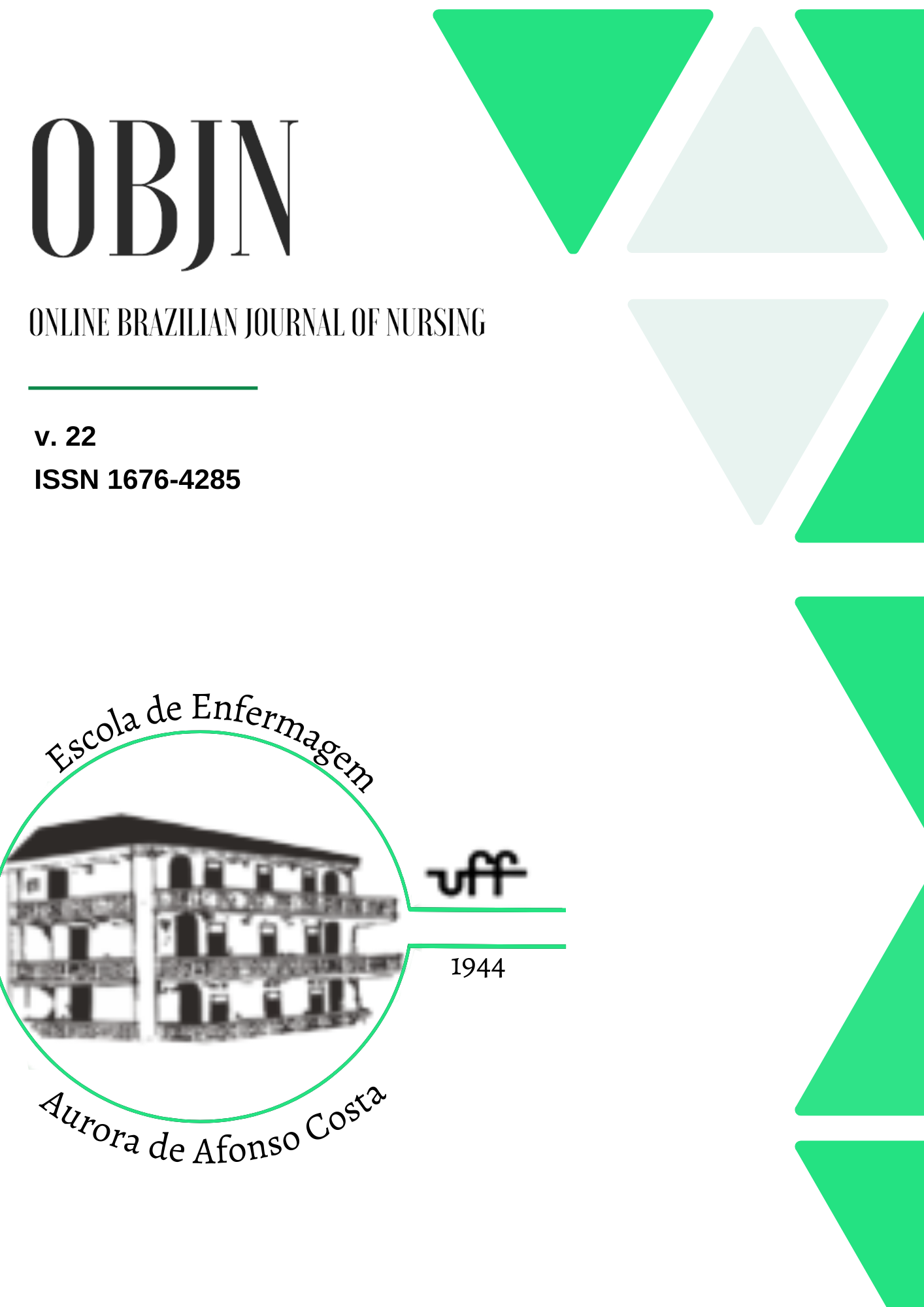Abstract
Objective: To identify and describe the profile of newborns who presented nasal septal injury using Noninvasive Ventilation and the treatment used. Method: Descriptive, exploratory research, with retrospective data collection in medical records of newborns hospitalized between January/2020 and December/2021, through a structured instrument, with simple descriptive frequency analysis. Results: Nasal septal injury was identified in 19.0% of newborns, with gestational age between 30-35 weeks and birth weight <1,500 grams. The most frequent stage of injury was I, treated with Askina spray + prong rotation, followed by Hydrocolloid + Dersani Hydrogel, between 1-7 days (36.4%). Conclusion: The nursing team encounters difficulties in the approach to newborns submitted to noninvasive ventilation with prong, making it relevant to invest in their qualification and in care protocols for skin care and for the performance of safe and humanized care.
References
Vanin LK, Zatti H, Soncini T, Nunes RD, Soqueira LBS. Maternal and fetal risk factors associated with late preterm infants. Rev Paul Pediatr. 2020;38: e2018136. https://doi.org/10.1590/1984-0462/2020/38/2018136
Shi Y, Luca D. Continuous positive airway pressure (CPAP) vs noninvasive positive pressure ventilation (NIPPV) vs noninvasive high frequency oscillation ventilation (NHFOV) as post-extubation support in preterm neonates: protocol for an assessor-blinded, multicenter, randomized controlled trial. BMC Pediatr. 2019 Jul 26;19(1):256. https://doi.org/10.1186/s12887-019-1625-1
Behnke J, Lemyre B, Czernik C, Zimmer K, Ehrhardt H, Waitz M. Non-invasive ventilation in neonatology. Dtsch Arztebl Int. 2019;116:177-83. https://doi.org.10.3238/arztebl.2019.0177
Black JM, Cuddigan JE, Walko MA, Didier LA, Lander MJ, Kelpe MR. Medical device related pressure ulcers in hospitalized patients. Int Wound J. 2019;5(7):358-65. https://doi.org/10.1111/j.1742-481X.2010.00699.x
Permall DL, Pasha AB, Chen XQ. Current insights in non-invasive ventilation for the treatment of neonatal respiratory disease. Ital J Pediatr. 2019;45(1):105. https://doi.org/10.1186/s13052-019-0707-x
Bishopp A, Oakes A, Antoine-Pitterson P, Chakraborty B, Comer D, Mukherjee R. The preventative effect of hydrocolloid dressings on nasal bridge pressure ulceration in acute non-invasive ventilation. Ulster Med J [Internet]. 2019 [cited 2022 Feb 15];88(1):17-20. Available from: https://www.ncbi.nlm.nih.gov/pmc/articles/PMC6342034/
Tamez RN. Enfermagem na UTI neonatal: assistência ao recém-nascido de alto risco. 6. ed. Rio de Janeiro (RJ): Guanabara Koogan; 2017.
Imbulana DI, Manley BJ, Dawson JA, Davis PG, Owen LS. Nasal injury in preterm infants receiving non-invasive respiratory support: a systematic review. Arch Dis Child Fetal Neonatal Ed. 2018;01(103):29-35. https://doi.org/10.1136/archdischild-2017-313418
Guedes BLS, Ferreira MMB, Mascarenhas MLVC, Ferreira ALC, Costa LC, Lúcio IML. Pressão positiva contínua nas vias aéreas em neonatos: cuidados prestados pela equipe de enfermagem. Esc Anna Nery. 2019;23(02):e20180122. https://doi.org/10.1590/2177-9465-EAN-2018-0122
Bashir T, Murki S, Kiran S, Reddy VK, Oleti TP. Nasal mask in comparison with 'nasal prongs' or 'rotation of nasal mask with nasal prongs' reduce the incidence of nasal injury in preterm neonates supported on nasal continuous positive airway pressure (nCPAP): a randomized controlled trial. PLoS One. 2019;14(01):e0211476. https://doi.org/10.1371/journal.pone.0211476
Khan J, Sundaram V, Murki S, Bhatti A, Saini SS, Kumar P. Nasal injury and comfort with jet versus bubble continuous positive airway pressure delivery systems in preterm infants with respiratory distress. Eur J Pediatr. 2017;176(12):1629-35. https://doi.org/10.1007/s00431-017-3016-7
Ribeiro DFC, Barros FS, Fernandes BL, Nakato AM, Nohama P. Nasal prongs: risks, injuries incidence and preventive approaches associated with their use in newborns. J Multidiscip Healthc. 2020;13:527-37. https://doi.org/10.2147/JMDH.S252017
Santos SV, Ramos FRS, Costa R, Batalha LMC. Evidence on prevention of skin lesions in newborns: integrative review. Braz J Enterostomal Ther. 2019;17:1-20. https://doi/org/10.30886/estima.v17.787_IN
Teo CSM, Claire CA, Lopez V, Shorey S. Pressure injury prevention and management practices among nurses: a realist case study. Int Wound J. 2019;01(16):153-63. https://doi.org/10.1111/iwj.13006
Azevedo TMD, Morais LL, Batista IBC. Prevalência de lesão de septo nasal em recém-nascidos prematuros por uso de pressão positiva contínua nas vias aéreas (CPAP) em uma unidade de terapia intensiva neonatal. ASSOBRAFIR Ciênc. 2022;13:e44541. http://dx.doi.org/10.47066/2177-9333.AC.2022.0049
Ribeiro DFC, Barros FS, Fernandes BL, Nakato AM, Nohama P. Incidence and severity of nasal injuries in preterm infants associated to non-invasive ventilation using short binasal prong. Glob Pediatr Health. 2021;8:2333794X211010459. https://doi.org/10.1177/2333794X211010459
Souza BHS, Sousa H, Oliveira HNS, Torres HVB, Pereira SA. Kinesio Taping® as an innovative therapeutic tool to prevent nasal septal lesions in newborns: a case study. Fisioter Mov. 2020;33. https://doi.org/10.1590/1980-5918.033.AO40
Aredes NDA, Santos RCA, Fonseca LMM. Skin care of premature newborns: integrative review Rev Eletr Enf. 2017;19:a59. http://doi.org/10.5216/ree.v19.43331
Rolim KMC, Farias CPX, Marques LC, Magalhaes FJ, Gurgel EPP, Caetano JA. Atuação da enfermeira na prevenção de lesão de pele do recém-nascido. Rev Enferm UERJ [Internet]. 2017 [cited 2022 Feb 05];17(4):544-9. Available from: https://www.facenf.uerj.br/v17n4/v17n4a16.pdf
Pontes S, Caxias CC, Silva ANN, Silva SMP, Lima AMF. Repercussões da ventilação não invasiva em recém-nascidos prematuros com síndrome do desconforto respiratório agudo: revisão integrativa. Rev Ciênc Plural. 2021;7(2):211-26. https://doi.org/10.21680/2446-7286.2021v7n2ID22612
Gan JE, Chin CY. Formulation and characterization of alginate hydrocolloid film dressing loaded with gallic acid for potential chronic wound healing. F1000Res. 2021;10:451. https://doi.org/10.12688/f1000research.52528.1
Ribeiro DFC, Barros FS, Fernandes BL, Nakato AM, Nahoma P. Hydrocolloid versus silicone gel for the prevention of nasal injury in newborns submitted to noninvasive ventilation: a randomized clinical trial. Heliyon. 2020;06(07):1-7. https://doi.org/10.1016/j.heliyon.2020.e04366
Barcellos AA, Mathiolli C, Lago MTG, Matos GM, Zani AV. Effects of music therapy on the physiological responses of preterm newborns on non-invasive ventilation: a quasi-experimental study. Online Braz J Nurs. 2021;20:e20216487. https://doi.org/10.17665/1676-4285.20216487
Milligan PS, Goldstein MR. Implementation of an evidence-based non-invasive respiratory support (NIRS) bundle in the NICU to decrease nasal injury complications. J Neonatal Nurs. 2017;23(2):89-98. https://doi.org/10.1016/j.jnn.2016.05.003
Martina COA, Curado MAS. Escala de observação do risco de lesão da pele em neonatos: validação estatística com recém-nascidos. Rev Enferm Ref. 2017;IV(13):43-52. https://doi.org/10.12707/RIV16082
Schaefer TIM, Neves ET, Jantsch LB, Magnago TSB de S. Avaliação das condições da pele do recém-nascido em terapia intensiva neonatal. Rev Enferm Atual. 2019;84(22):33-44. https://doi.org/10.31011/reaid-2018-v.84-n.22-art.265

This work is licensed under a Creative Commons Attribution 4.0 International License.
Copyright (c) 2023 Array

